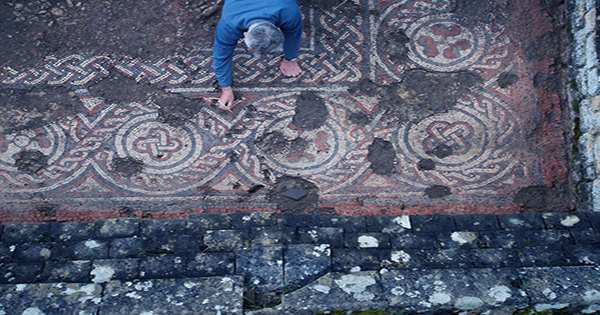Fans of Time Team will be overjoyed to learn that a pottery trail led to the discovery of a villa hidden beneath a farmer’s field in Rutland, United Kingdom. Most notably, it has “the most intriguing Roman mosaic find in the UK in the previous Century,” according to the press. The mosaic is the first in the UK to show scenes from Homer’s The Iliad, and mosaics depicting scenes from Homer’s The Iliad are a rare breed even across Europe.
The fact that it discovered inside the setting of a villa adds to the site’s academic worth, which has now safeguarded by Historic England and the Department for Digital, Culture, Media and Sport.
“The fact that we have the wider context of the surrounding complex is hugely significant,” said John Thomas, Deputy Director of University of Leicester Archaeological Services (ULAS) and project manager on the excavations, in a statement.
“Previous excavations on Roman villas have only been able to capture partial pictures of settlements like these, but this appears to be a very well-preserved example of a villa in its entirety.”
“It provides new insights into people’s opinions at the period, their connections to classical literature, and it also reveals a great deal about the person who commissioned the piece.”
This is someone who knows the classics, who has the financial means to commission such a performance, and it is the first portrayal of these stories we have ever seen in Britain.
It discovered coincidence by the landowner’s son, Jim Irvine, and is the stuff of relic aficionados’ fantasies. Irvine claims he found uncovered an interesting piece of pottery among some wheat while going across the fields during the lockdown in 2020, which caught his curiosity. He looked to satellite images for more indications as to its origin, and there was the Eureka Moment when they revealed a visible crop mark.
Due to collaboration with archaeologists from the University of Leicester and Historic England, the team was able to secure funding for urgent archaeological research, and work began in the summer. Their efforts rewarded with the discovery of the ruins of a Roman mosaic depicting the Greek hero Achilles, spanning 11 by 7 meters (36 by 23 feet).
It is supposed to have been part of a big villa from the 3rd and 4th centuries AD, and used as a dining or entertainment room, by late Roman Period standards, the owner was most likely affluent and an arts patron, since the unusual mosaic appears to express a taste for classical literature.
“Over the last year, this archaeological find has taken up much of my free time,” Irvine stated. “It’s kept me quite busy between my regular work and this, and it’s been a wonderful ride.” It’s been a genuine delight to be a part of, and to work with, the archaeologists and students at the site over the last year, and I can’t wait to see what’s next!” The site now legally protected and has been backfilled to ensure that future generations will be able to enjoy it, if you interested in learning more about the Rutland Villa’s discovery; BBC Two’s Digging for Britain will air a show on it in 2022.















